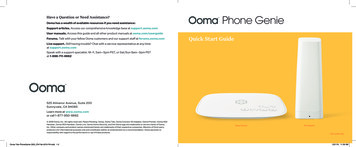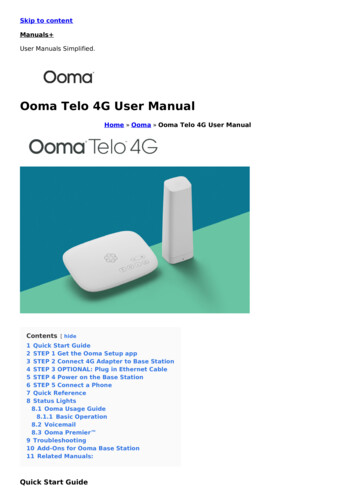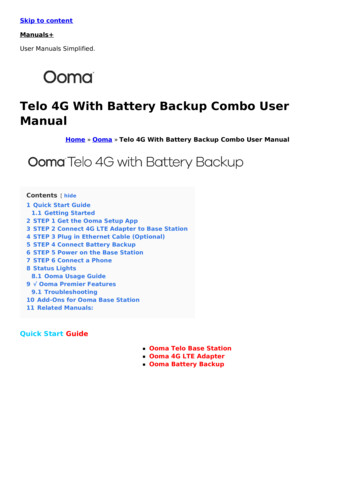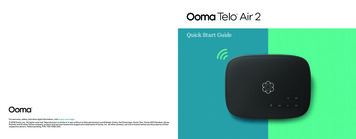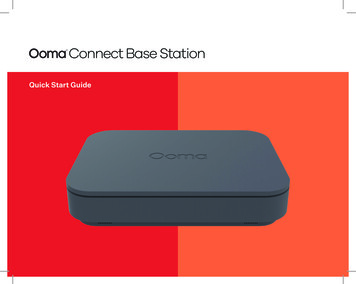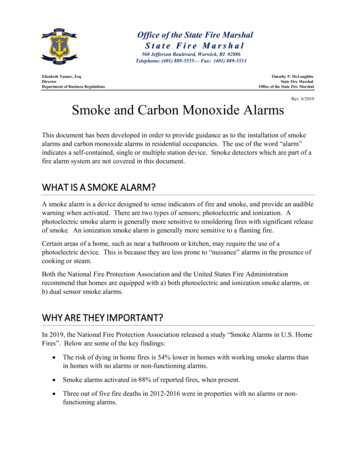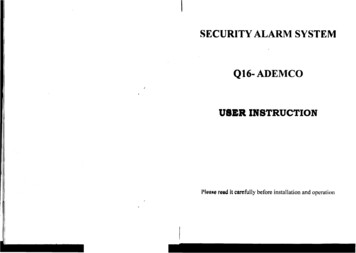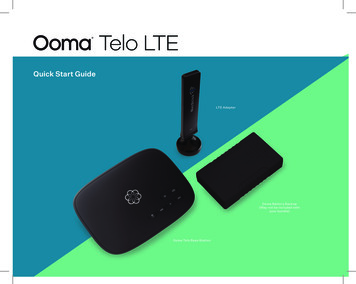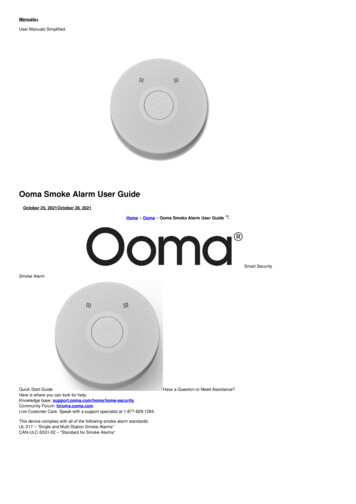
Transcription
Manuals User Manuals Simplified.Ooma Smoke Alarm User GuideOctober 25, 2021October 28, 2021Home » Ooma » Ooma Smoke Alarm User GuideSmart SecuritySmoke AlarmQuick Start GuideHere is where you can look for help:Knowledge base: support.ooma.com/home/home-securityCommunity Forum: forums.ooma.comLive Customer Care. Speak with a support specialist at 1-877-629-1284.This device complies with all of the following smoke alarm standards:UL 217 – “Single and Multi-Station Smoke Alarms”CAN-ULC-S531-02 – “Standard for Smoke Alarms”Have a Question or Need Assistance?
P/N: 700-0177-202Contents [ hide1 What to Do in Case of Fire2 Key Features3 Power On Your Smoke Alarm4 Test Your Smoke Alarm5 Mount Your Smoke Alarm6 Nuisance Alarms7 Cleaning Your Smoke Alarm8 Deactivating and Replacing Your SmokeAlarm9 Warnings and Limitations10 Where Not to Install Your Smoke Alarm11 NFPA Requirements12 Documents / Resources12.1 References12.2 Related Manuals / ResourcesWhat to Do in Case of Fire Have a family escape plan. Know the exit routes out of your home.Have a designated meeting place outside of your home. Do not panic. Stay calm. Get everyone to exit the building as quickly as possible. Do not stop to collect anything. Feel doors with the back of your hand before opening them. If a door is cool, open it slowly. Do not open a hot door. Keep doors and windows closed unless you must escape through them. Cover your nose and mouth with a damp cloth. Take short, shallow breaths. Meet at your designated meeting place and do a headcount. Call the fire department as soon as possible from outside the building. Give your address followed by your name. Never go back inside a burning building for any reason.Key FeaturesYour Ooma Smoke Alarm functions as a complete standalone smoke alarm once powered on. The Ooma Smoke Alarm is intended for use in single-family residencesonly.A. Test/Hush ButtonB. Status indicator light ringC. Speaker ports
A pack of two lithium-ion batteries, permanently sealed inside the alarm, powers this unit.No battery installation or replacement is necessary forthe life of the alarm.D. Pairing buttonE. Tamper buttonF. Deactivation holeWARNING: DO NOT ATTEMPT TO OPEN THE ALARM FOR ANY REASONSTEP 1Power On Your Smoke AlarmRemove the mounting plate from your Ooma Smoke Alarm by twisting it counterclockwise.Use something narrow like a pencil to quickly press the Pairing button, labeled PAIRING. Your smoke alarm will power on and sound three loud beeps. The statusindicator light ring will blink red while the device initializes. When it stops blinking, your smoke alarm is ready to detect smoke. This feature is intended for one-time useonly.Test Your Smoke AlarmSTEP 2
Press and hold the test button for one second. It will blink red and sound three loud beeps to indicate that it is functioning correctly. If it does not, please contact ourcustomer support team. The National Fire Protection Association (NFPA) recommends that you perform this test on all smoke alarms at least once a week. Never usean actual flame to test your alarm.Mount Your Smoke AlarmThe NFPA recommends installing a smoke alarm in the following areas: On every floor, including finished attics and basements. Inside and outside every sleeping area. At the top of the first-to-second floor stairway and on the basement ceiling near the entry of the stairs. In homes with more than 1,000 square feet on one level, additional alarms may be required.Placement on the ceiling or wallIt is recommended that you install your Ooma Smoke Alarm on the ceiling. Make sure it is at least 4 inches away from the wall.Placement on a sloped ceilingIf you have a sloped, peaked, or cathedral ceiling, your Ooma Smoke Alarm should be 4 inches to 3 feet from the highest point.STEP 3
Screw the mounting plate to the ceiling or wallusing the included screws and drywall anchors.Then, hold your Ooma Smoke Alarm against the mounting plate and turn it clockwise to secure it.Nuisance AlarmsNuisance alarms can be caused by things like fumes from cooking or exhaust from a motor vehicle.To stop a nuisance alarm, press the Hush button, which is also the Test button, on your Ooma Smoke Alarm. This will hush the alarm for up to five minutes. Remove thesource of the nuisance alarm and clear the air surrounding the smoke alarm.Never try to avoid false alarms by disabling the device. If the nuisance alarm persists, clean your Ooma Smoke Alarm as described in this quick start guide.
Cleaning Your Smoke AlarmTo ensure that your Ooma Smoke Alarm functions properly, we recommend that you clean it at least once a year. To do this, remove it from the mounting plate byturning it counterclockwise. Use a soft brush to remove any dust from the openings around the device. Never use water, cleaners, or solvents to clean your OomaSmoke Alarm.Initial Setup and PairingAlarm and Status Light Indicator Reference
What You HearWhat You SeeWhat It MeansWhat To DoThree beepsRed flashes (approximately 20 seconds)Smoke alarm initializingWait for initialization to completeNoneGreen flashesPairing modeFollow in-app instructionsNoneLong Green pulse for 3 secondsPairing successfulThe complete in-app pairingprocessNoneRed flashes for 10 secondsPairing failedTry pairing againAlarm ConditionsWhat You HearWhat You SeeWhat It MeansWhat To DoThree beeps, pause, repeatingcontinuouslyRed flashesSmoke detectedEvacuate immediately. If nuisancealarm, resolve itNoneRed flashesAlarm hushedResolve nuisance alarm sourceTesting and MaintenanceWhat You HearWhat You SeeWhat It MeansWhat To DoOne chirp (20ms) every minuteOne red flash every minuteLow battery/ End of lifeReplace your smoke alarm immediatelyThree beepsOne red flashTest succeededNo action neededOne beepOne red flashTest failedContact Ooma supportOne beep (200ms) every minuteOne red flash every minuteTrouble signalContact Ooma supportDeactivating and Replacing Your Smoke AlarmThis smoke alarm has an expected life of 10 years. When it needs to be replaced, this alarm has a low battery monitor which will cause the device to “chirp” everyminute for a minimum of thirty (30) days. When this happens, you should immediately purchase and install another Ooma Smoke Alarm to ensure that your homeremains protected.To permanently deactivate the a device, follow these instructions:and remove it from the mounting bracket.First, rotate the device counterclockwisePress the PAIRING button, TEST button, and TAMPER button simultaneously to deactivate it. The unit will no longer function once put into this mode.
WARNING: ONCE THE DEVICE HAS BEENDEACTIVATED, IT CANNOT BE RE-MOUNTED ONTO THE MOUNTING BRACKET.Use a tool, such as a screwdriver, to take out the red pin from its insert and push it into the square hole. When fixed, the red part will prevent the device from being remounted onto the mounting bracket.Warnings and LimitationsSmoke alarms only work if they are properly installed, maintained, and if smoke reaches the alarm. The following warnings and indications will help avoid false alarms ortrouble signals: This smoke alarm will not work if it has not been powered on. To power it on, follow the setup instructions in this quick start guide. This smoke alarm uses photoelectric detection technology to detect smoke in a residential environment. Photoelectric detection is generally more sensitive thanionization technology at detecting large particles, which tend to be produced by slow-smoldering fires. Sources of large particles include cigarettes burning in couches orbedding. It is also recommended to purchase and install ionization smoke alarms, which are more sensitive to small particles from fast-flaming fires. Sources of small particlesinclude paper burning or grease fires in the kitchen. NOTICE: The National Fire Protection Association standard requires that smoke alarm batteries last at least 10 years and be non-replaceable andnon-removable. Our batteries are certified by the relevant authorities to meet these requirements on a stand-alone basis. However, if you pair anOoma smoke alarm with an Ooma Telo Base Station, the battery life may not last 10 years. To maximize optimum battery life, you must make surethe Smoke Alarm has a good and uninterrupted connection to the OomaTelo base station. It is your responsibility to keep the equipment in good working order as stated elsewhere herein. Smoke alarms are not foolproof and cannot prevent or extinguish fires. This smoke alarm may not be heard if the occupants are impaired or if the alarm is drowned out by surrounding noise. Special smoke alarms should be installed forresidents who are hearing impaired. This smoke alarm will not work if its surroundings prevent smoke particles from reaching the detector. Do not stand close to the smoke alarm when it is sounding. Prolonged exposure to the alarm may cause hearing damage. Do not paint over your smoke alarm as this may prevent smoke particles from reaching the detector. The smoke alarm may not be effective for fires where the victim is in close contact with a flame; for example, when a person’s clothes catch fire while cooking. The smoke alarm may not be effective for fires where the smoke is prevented from reaching the smoke alarm due to a closed-door or other obstruction. The smoke alarm may not be effective for incendiary fires where the fire grows so rapidly that an occupant’s egress is blocked even with properly located smokealarms. This smoke alarm should not be installed in locations where the normal ambient temperature is below 40 F (4.4 C) or exceeds 100 F (37.8 C),unless the alarm has been determined to be capable of being used at installation points with higher or lower ambient temperatures. Studies have shown smoke alarms may not awaken all sleeping individuals. It is the responsibility of individuals in the household that are capable ofassisting others to aid those who may not be awakened by the alarm sound, or to those who may be incapable of safely evacuating the area unassisted. This smoke alarm will emit a “trouble” alarm if a critical component has failed.Where Not to Install Your Smoke Alarm Do not install smoke alarms in areas where combustion particles are produced, such as kitchens or garages. Installing in these areas will cause unnecessary nuisancealarms. Keep a smoke alarm at least 20 feet from the source of combustion particles if possible.
Do not install smoke alarms in the path of air vents. Installing in this area will reduce the effectiveness of your alarm. Do not install smoke alarms in damp or very humid areas, such as bathrooms or showers. Moisture in humid air can enter the sensing chamber, which can causenuisance alarms. Install smoke alarms at least 10 feet away from bathrooms. Do not install smoke alarms in areas where the ambient temperature is below 14 F (-10 C) or above 131 F (55 C). Smoke alarms maynot function properly at extreme temperatures. Do not install smoke alarms in very dusty or dirty areas. Installing in these areas will cause unnecessary nuisance alarms. Do not install in “dead air” spaces, such as at the top of a peaked roof or in the corners between ceilings and walls. Dead air may prevent smoke from reaching youralarm. Do not install smoke alarms in insect-infested areas. Insects can enter the sensing chamber, causing unnecessary nuisance alarms. Do not install smoke alarms near LED or fluorescent lights, which emit electrical noise that may cause nuisance alarms. Install smoke alarms at least 5 feet from LEDor fluorescent lights.NFPA RequirementsThe Ooma Smoke Alarm is intended for use in single-family homes and apartments. It is not designed for compliance with Occupational Safety and HealthAdministration (OSHA) commercial or industrial standards.This equipment should be installed in accordance with the National Fire Protection Association’sStandard 72 (National Fire Protection Association, Batterymarch Park, Quincy, MA 02269).NFPA 72 reads as follows: “29.5.1* Required Detection.” “29.5.1.1* Where required by other governinglaws, codes, or standards for a specific type of occupancy, approved single and multiple-station smoke alarms shall be installed as follows:1.2.3.4.5.6.*In all sleeping rooms and guest rooms*Outside of each separate dwelling unit sleeping area, within 21 ft (6.4 m) of any door to a sleeping room, with the distance measured along a path of travelOn every level of a dwelling unit, including basementsOn every level of a residential board and care occupancy (small facility), including basements and excluding crawl spaces and unfinished attics*In the living area(s) of a guest suiteIn the living area(s) of a residential board and care occupancy (small facility)”Reprinted with permission from NFPA 72 , National Fire Alarm Code Copyright 2016 National Fire Protection Association, Quincy, MA 02269. This reprinted materialis not the complete and official position of the National Fire Protection Association, on the referenced subject which is represented only by the standard in its entirety.National Fire Alarm Code and NFPA 72 have registered trademarks of the National Fire Protection Association, Inc., Quincy, MA 02269.Documents / ResourcesOoma Smoke Alarm [pdf] User GuideOoma, Smoke, AlarmReferencesOoma Forums -Index pageRedirecting Related Manuals / ResourcesOoma Smoke Alarm Sensor User ManualOoma Smoke Alarm Sensor User Manual - Optimized PDF Ooma Smoke Alarm Sensor User Manual Original PDFBE1289 Smoke Alarm User ManualBE1289 Smoke Alarm User Manual - Optimized PDF BE1289 Smoke Alarm User Manual - Original PDFFLAMINGO Alarm Smoke Detector User ManualFLAMINGO Alarm Smoke Detector GENERAL This alarm is a smoke detector of the photo cell principle. Thismeans MacBook User GuideMacBook User Guide - Download [optimized]MacBook User Guide - DownloadManuals ,homeprivacy
Ooma Smoke Alarm User Guide October 25, 2021October 28, 2021 . When it stops blinking, your smoke alarm is ready to detect smoke. This feature is intended for one-time use . Press and hold the test button for one second. It will blink red and sound three loud beeps to indicate that it is functioning correctly. If it does not, please contact our
